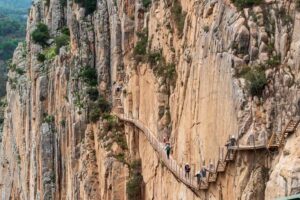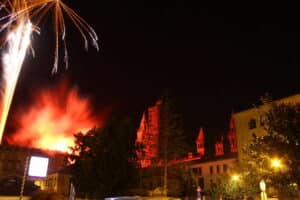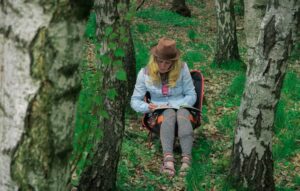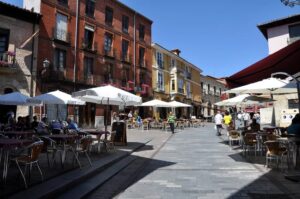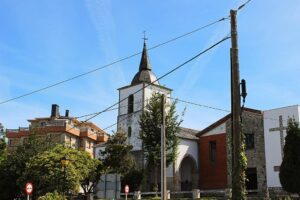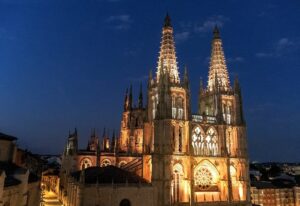To get to Santiago de Compostela and do a trip to the Camino de Santiago organized there are several options. Therefore, it is easy to find the one that best suits the needs of each pilgrim.
El Primitive Way It is the route that begins in Oviedo to later join the French Way in Melide (being the Way of Saint James from Sarria to Santiago the most popular option of this last variant). Its name is due to the fact that it was just the first of which there are historical references.
It was King Alfonso II of Asturias who, in the company of his entourage, left Oviedo on a pilgrimage to the tomb of the Apostle Santiago, which had been discovered a few years ago, in the XNUMXth century. That journey was documented and the pilgrimage keeps quite a few coincidences with the current route.
Índice de contenidos
- 1 These are the most important monuments of the primitive path that you should not miss
- 1.1 Cathedral of San Salvador in Oviedo
- 1.2 University of Oviedo
- 1.3 Monastery of San Salvador de Cornellana
- 1.4 Collegiate Church of Santa María la Mayor
- 1.5 Monastery of Santa María la Real de Obona
- 1.6 Palace of Cienfuegos de Peñalba
- 1.7 Parish Church of Salvador de Grandas de Salime
- 1.8 Bye Samartin
- 1.9 Holly Harbor
- 1.10 Lugo city wall
These are the most important monuments of the primitive path that you should not miss
There are many points of interest Primitive Way that can be enjoyed. For us, the most notable are the following.
Cathedral of San Salvador in Oviedo
Without a doubt, this is one of the most important buildings on the Primitive Way and you can even visit it before starting the route. Is It is a Gothic-style cathedral, also known as Holy Ovetensis, for the large number of relics that rest there.
started to build at the end of the XNUMXth century, with the construction of the cloister and the chapter house. This work lasted for at least three centuries, when the tower was completed in the XNUMXth century. Later, some pieces continued to be added, such as the chapels.
It was built where in the XNUMXth century there was a pre-Romanesque cathedral complex. In fact, some of these ancient elements can still be seen today. UNESCO declared the Holy Chamber as a World Heritage Site. This is the place where the crosses of angels and victory are found, the main symbols of Oviedo and Asturias.
University of Oviedo
It was founded in the XNUMXth century by the city’s archbishop, Fernando Valdés Salas, He began his academic activities in 1608 with the faculties of Law, Theology, Canons and Arts, although its promoter died in 1568.
In 1934, in the framework of the coup against the Republic, communists and socialists burned and destroyed it, including the art gallery and the library. After the Civil War it was rebuilt, although some had the intention of moving it to Santander.
Monastery of San Salvador de Cornellana
Another of the most important buildings on the Camino Primitivo. It was founded by the infanta Cristina, daughter of King Bermudo II, and his mother, Queen Velasquita in 1024. The latter lived in this place precisely after the death of the monarch.
This architectural complex also includes a church with a basilica plan with three naves that are separated by cruciform pillars. After the death of the Infanta Cristina, the monastery passed into the hands of the monks of Cluny in 1122.
A famous relief of a bear nursing a girl with two lion heads on each side still remains above the garden gate. Legend has it that a girl, the infanta, got lost in the forest when she was still very young and she managed to survive thanks to the protection of this animal.
Collegiate Church of Santa María la Mayor
Located in the town of Toro, in Zamora, it is a Gothic-Romanesque style church. Its construction began around 1170 under the reign of Fernando II de León, although it was not until the XNUMXth century that the work was completed.
In this construction it is possible distinguish two different eras: The first, in Romanesque style with limestone in light tones, and the second with less evolved elements such as the reddish sandstone that covers the temple.
Here it is possible to enjoy the museum, that shows valuable works of sculpture and painting of a religious nature.
Monastery of Santa María la Real de Obona
Although there is a founding document of the monastery, its origins are not entirely clear. Its foundation is attributed to the son of King Silo, Adelgaster in the year 871. On the other hand, some documents certify that already in the XNUMXth and XNUMXth century it was an important Benedictine center.
King Alfonso IX, after visiting him, granted him the power to be Mandatory passage of pilgrims to Santiago. Its heyday of greatest splendor was around the XNUMXth century, when the monks taught classes, as well as being an important center for livestock and agricultural exploitation.
The set is composed of the temple, convent rooms, the cloister and the hostelry. The church is the oldest building today.
Palace of Cienfuegos de Peñalba
It is situated on a old fort, on a hill near Pola de Allande. Originally it belonged to Los Ponce, but later it passed into the hands of the Counts of Luna and from 1515 to the Cienfuegos.
In 1520 it was rebuilt on what was the original XNUMXth century building, although it later underwent other reforms. This has resulted in his original gothic style only remains on the ground floor.
It is L-shaped, with three towers, two of which are square, while the third is rectangular.
Parish Church of Salvador de Grandas de Salime
old collegiate church. Its origins go back to the year 1186 when it is already reflected as one of the points of interest on the Camino Primitivo. Over time, It has undergone different reforms, so the styles have been combined,conserving only the old Romanesque cover.
The church has a plan in the shape of a Latin cross and a single tower. This is surrounded by a portico that was built in the XNUMXth century where pilgrims were sheltered.
Bye Samartin
This medieval necropolis It was only recognized as Castro in 1967. It is believed that the origin of this settlement dates back to the Bronze Age, around 800 BC It was established on the upper esplanade, considering it as the first fortified enclosure.
Later, in the Iron Age, its defenses were renewed several times. Later, in the Roman epic, it reached a leading role at the administrative level. Finally, in the second century it was almost completely destroyed by a devastating earthquake.
Holly Harbor
One of the most beautiful landscapes of the entire Camino Primitivo. Is about a series of mills, those of Cornellana, which offer a wonderful image thanks to their imposing size and perfect white color.
They are of the latest technology, which combine perfectly with the heather that creates a beautiful rug.

Lugo city wall
The last, but not least of all the most important monuments of the Camino Primitivo. The Roman Wall of Lugo enjoy the privilege of being the only one in the world that is preserved whole, being declared a World Heritage Site by Unesco.
It is 2.266 meters long and has 71 towers, although originally there were 85.. They perfectly define the old town of Lugo.
It was built around the 13th century BC According to legend it was not precisely to protect the city but the Sacred Forest of Lucus Augusti, from which the name of Lugo was born centuries later.

